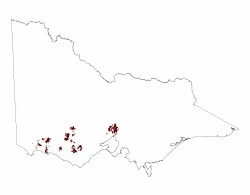6.1.2 Stony rises (Mt. Eccles, Pomborneit, Mt. Rouse)
6. Western Plains (WP)
6.1 Volcanic plains
| Stony rise lava flows represent the most recent volcanic activity, and among the most prominent stony rises are those of Mount Porndon (289 m) where scoria cones rise above a high “ring barrier” of lava, with more extensive lower level flows extending radially, including northwards to Mt Corangamite. This volcano and its stony rise flows have been dated as 59 000 years old, placing it among the youngest landforms in Australia (Stone et al. 1977). Younger stony rises form the most rocky and undulating landscapes, such as the area of flows from Mt Porndon around Pomborneit East, south of Lake Corangamite. These landscapes are characterised by stony mounds with little or no soil and no surface drainage development. The younger stony rises of less than 100,000 years age are classified as the Eccles Regolith Landform Unit (Joyce 1999). Older stony rise landscapes, such as north of Dreeite, have some soil development and some small ephemeral lakes, swamps and wetlands which have formed in the depressions, but no significant surface drainage systems. The older stony rises of more than 100,000 years and up to one million years in age are classified as the Rouse Regolith Landform Unit (Joyce 1999). Associated soil types are shallow dark gradational (Dermosols) and self-mulching (and cracking) clay soils (Vertosols). As the stony rise landscapes developed through geological time, they evolved into plains with poorly developed drainage (geomorphological unit 6.1.3). |  |
The regolith and associated soils of unit 6.1.2 have been described as the Eccles and Rouse Regolith Landform Units of Joyce 1999.
Related information on VRO
Eruption Points of the Newer Volcanics - Rosengren 1994


